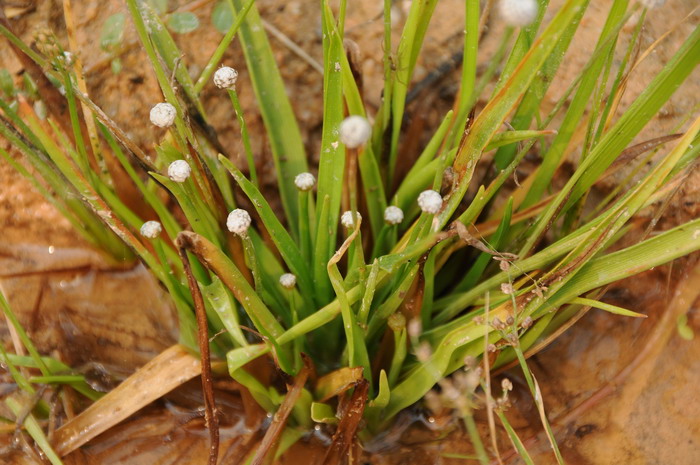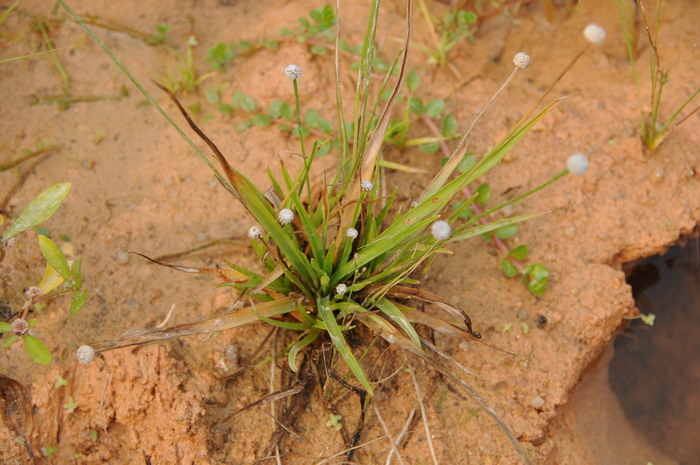华南谷精草Eriocaulon sexangulare
中文名(Chinese Name):华南谷精草
学名(Scientific Name):Eriocaulon sexangulare L.
英文名(English Common Name):
别名(Chinese Common Name):谷精珠、大叶谷精草
异名(Synonym): Eriocaulon cantoniensis Hook. et Arn. Eriocaulon sinicum Miq. Eriocaulon sinii Ruhland Eriocaulon willdenovianum Moldenke Eriocaulon contoniense Hook et Arn. Eriocaulon miyagianum Koidz. Eriocaulon myriophyllum Wall. Eriocaulon kwangtungense Ruhland Eriocaulon consanguineum Kunth Eriocaulon quandrangulare Lour. Eriocaulon petrosepalum Hayata Eriocaulon pterospermum Hayata Eriocaulon cantoniense Hook. & Arn. Eriocaulon quadrangulare Lour. Eriocaulon sexangulare var. micronesicum Moldenke Eriocaulon wallichianum var. tenellum Wight ex Moldenke Eriocaulon quadriangulare Lour. ex Moldenke
科属(Family & Genus):谷精草科(Eriocaulaceae)谷精草属
形态特征(Description):大型草本。叶丛生,线形,长10-37厘米,宽4-13毫米,先端钝,叶质较厚,对光能见横格,脉15-37条。花葶5-20,长可达60厘米,干时粗1.1毫米,扭转,具4-6棱,鞘状苞片长4-12厘米,口部斜裂,裂片禾叶状;花序熟时近球形,不压扁,灰白色,直径6.5毫米,基部平截;总苞片倒卵形,禾秆色,平展,硬膜质,直径2.2-2.4毫米,背面有白短毛,下部的长,由3个细胞接成,上部的为单细胞短毛,边缘无毛;总(花)托无毛;苞片倒卵形至倒卵状楔形,径2-2.5毫米,背上部有白短毛;雄花:花萼合生,佛焰苞状,近轴处深裂至半裂,顶端3(-2)浅裂,有时顶端平截不见分裂,两侧片具翅,翅端为不整齐齿状,无毛;花冠3裂,裂片条形,常各有1不明显的腺体,裂片顶端有短毛;雄蕊6枚,偶见5或4枚;花药黑色;雌花:萼片3枚,偶2,无毛,侧片2,舟形,长2-2.3毫米,背面有宽翅,翅端齿状,中萼片(近轴萼片)较小,无翅,长1.7-0-25毫米,线形、圆形至二叉状,甚至完全退化;花瓣3枚,膜质,线形,中片(远轴瓣)稍大,近顶处各有1淡棕色、不明显的腺体,顶端有白短毛,中下部侧面有时有长柔毛;子房3室,花柱分枝3,花柱扁。种子卵形,长0.58-0.7毫米,表面具横格及T字形毛。花果期夏秋至冬季。
分布(Distribution):产福建、台湾、广东、海南、广西。生于海拔760米以下池塘、稻田边。东南亚也有。
用途(Use):
引自中国植物志英文版FOC Vol. 24 Page 11
Eriocaulon sexangulare Linnaeus, Sp. Pl. 1: 87. 1753.
华南谷精草 hua nan gu jing cao | Eriocaulaceae | Eriocaulon
Eriocaulon cantoniensis Hooker & Arnott; E. pterosepalum Hayata; E. sinicum Miquel; E. sinii Ruhland; E. wallichianum Martius.
Leaves linear, 10--35 cm, 4--13 mm wide at middle, veins 15--37. Scapes 5--20, 20--60 cm, 4--6-ribbed; sheath 4--12 cm; receptacle glabrous; heads subglobose, ca. 6.5 mm in diam., glaucous, base truncate; involucral bracts straw-colored, obovate, 2.2--2.4 mm in diam., rigid, abaxially white clavate hairy; floral bracts obovate to obovate-cuneate, 2--2.5 mm, abaxially hairy toward apex. Male flowers: sepals spathelike, glabrous, laterally winged, apex (2 or)3-lobed or occasionally truncate; petals (2 or)3, linear, apex pubescent, gland usually indistinct; anthers (4--)6, black. Female flowers: sepals (2 or)3, free, glabrous, posterior one smaller than others, sometimes reduced or absent, wingless, lateral ones boatlike, winged; petals (2 or)3, linear, unequal, membranous, occasionally villous at center, apex white clavate hairy; ovary (2 or)3-loculed; style (2 or)3-cleft. Seeds ovoid, 0.6--0.7 mm; testa hexagonally reticulate, prickles 1 per cell, T-shaped. Fl. and fr. Aug--Mar.
Ponds, rice fields; near sea level to 800 m. Fujian, Guangdong, Guangxi, Hainan, Taiwan [Cambodia, India, Indonesia, Japan, Laos, Malaysia, Myanmar, Philippines, Sri Lanka, Thailand, Vietnam; Africa (including Madagascar)].
The 2-merous form that is occasionally found in China resulted in the 2-merous Eriocaulon willdenovianum Moldenke ( E. longifolium Nees ex Kunth (1841), not Rafinesque (1840)) being put in synonymy under E. sexangulare in FRPS. These two species are distinct outside of China, and it is possible that the 2-merous plants in China represent a reduction from 3-merous to 2-merous within E. sexangulare. This question needs further study.


(责任编辑:徐晔春)
学名(Scientific Name):Eriocaulon sexangulare L.
英文名(English Common Name):
别名(Chinese Common Name):谷精珠、大叶谷精草
异名(Synonym): Eriocaulon cantoniensis Hook. et Arn. Eriocaulon sinicum Miq. Eriocaulon sinii Ruhland Eriocaulon willdenovianum Moldenke Eriocaulon contoniense Hook et Arn. Eriocaulon miyagianum Koidz. Eriocaulon myriophyllum Wall. Eriocaulon kwangtungense Ruhland Eriocaulon consanguineum Kunth Eriocaulon quandrangulare Lour. Eriocaulon petrosepalum Hayata Eriocaulon pterospermum Hayata Eriocaulon cantoniense Hook. & Arn. Eriocaulon quadrangulare Lour. Eriocaulon sexangulare var. micronesicum Moldenke Eriocaulon wallichianum var. tenellum Wight ex Moldenke Eriocaulon quadriangulare Lour. ex Moldenke
科属(Family & Genus):谷精草科(Eriocaulaceae)谷精草属
形态特征(Description):大型草本。叶丛生,线形,长10-37厘米,宽4-13毫米,先端钝,叶质较厚,对光能见横格,脉15-37条。花葶5-20,长可达60厘米,干时粗1.1毫米,扭转,具4-6棱,鞘状苞片长4-12厘米,口部斜裂,裂片禾叶状;花序熟时近球形,不压扁,灰白色,直径6.5毫米,基部平截;总苞片倒卵形,禾秆色,平展,硬膜质,直径2.2-2.4毫米,背面有白短毛,下部的长,由3个细胞接成,上部的为单细胞短毛,边缘无毛;总(花)托无毛;苞片倒卵形至倒卵状楔形,径2-2.5毫米,背上部有白短毛;雄花:花萼合生,佛焰苞状,近轴处深裂至半裂,顶端3(-2)浅裂,有时顶端平截不见分裂,两侧片具翅,翅端为不整齐齿状,无毛;花冠3裂,裂片条形,常各有1不明显的腺体,裂片顶端有短毛;雄蕊6枚,偶见5或4枚;花药黑色;雌花:萼片3枚,偶2,无毛,侧片2,舟形,长2-2.3毫米,背面有宽翅,翅端齿状,中萼片(近轴萼片)较小,无翅,长1.7-0-25毫米,线形、圆形至二叉状,甚至完全退化;花瓣3枚,膜质,线形,中片(远轴瓣)稍大,近顶处各有1淡棕色、不明显的腺体,顶端有白短毛,中下部侧面有时有长柔毛;子房3室,花柱分枝3,花柱扁。种子卵形,长0.58-0.7毫米,表面具横格及T字形毛。花果期夏秋至冬季。
分布(Distribution):产福建、台湾、广东、海南、广西。生于海拔760米以下池塘、稻田边。东南亚也有。
用途(Use):
引自中国植物志英文版FOC Vol. 24 Page 11
Eriocaulon sexangulare Linnaeus, Sp. Pl. 1: 87. 1753.
华南谷精草 hua nan gu jing cao | Eriocaulaceae | Eriocaulon
Eriocaulon cantoniensis Hooker & Arnott; E. pterosepalum Hayata; E. sinicum Miquel; E. sinii Ruhland; E. wallichianum Martius.
Leaves linear, 10--35 cm, 4--13 mm wide at middle, veins 15--37. Scapes 5--20, 20--60 cm, 4--6-ribbed; sheath 4--12 cm; receptacle glabrous; heads subglobose, ca. 6.5 mm in diam., glaucous, base truncate; involucral bracts straw-colored, obovate, 2.2--2.4 mm in diam., rigid, abaxially white clavate hairy; floral bracts obovate to obovate-cuneate, 2--2.5 mm, abaxially hairy toward apex. Male flowers: sepals spathelike, glabrous, laterally winged, apex (2 or)3-lobed or occasionally truncate; petals (2 or)3, linear, apex pubescent, gland usually indistinct; anthers (4--)6, black. Female flowers: sepals (2 or)3, free, glabrous, posterior one smaller than others, sometimes reduced or absent, wingless, lateral ones boatlike, winged; petals (2 or)3, linear, unequal, membranous, occasionally villous at center, apex white clavate hairy; ovary (2 or)3-loculed; style (2 or)3-cleft. Seeds ovoid, 0.6--0.7 mm; testa hexagonally reticulate, prickles 1 per cell, T-shaped. Fl. and fr. Aug--Mar.
Ponds, rice fields; near sea level to 800 m. Fujian, Guangdong, Guangxi, Hainan, Taiwan [Cambodia, India, Indonesia, Japan, Laos, Malaysia, Myanmar, Philippines, Sri Lanka, Thailand, Vietnam; Africa (including Madagascar)].
The 2-merous form that is occasionally found in China resulted in the 2-merous Eriocaulon willdenovianum Moldenke ( E. longifolium Nees ex Kunth (1841), not Rafinesque (1840)) being put in synonymy under E. sexangulare in FRPS. These two species are distinct outside of China, and it is possible that the 2-merous plants in China represent a reduction from 3-merous to 2-merous within E. sexangulare. This question needs further study.
(责任编辑:徐晔春)
踩一下[1]

顶一下[0]